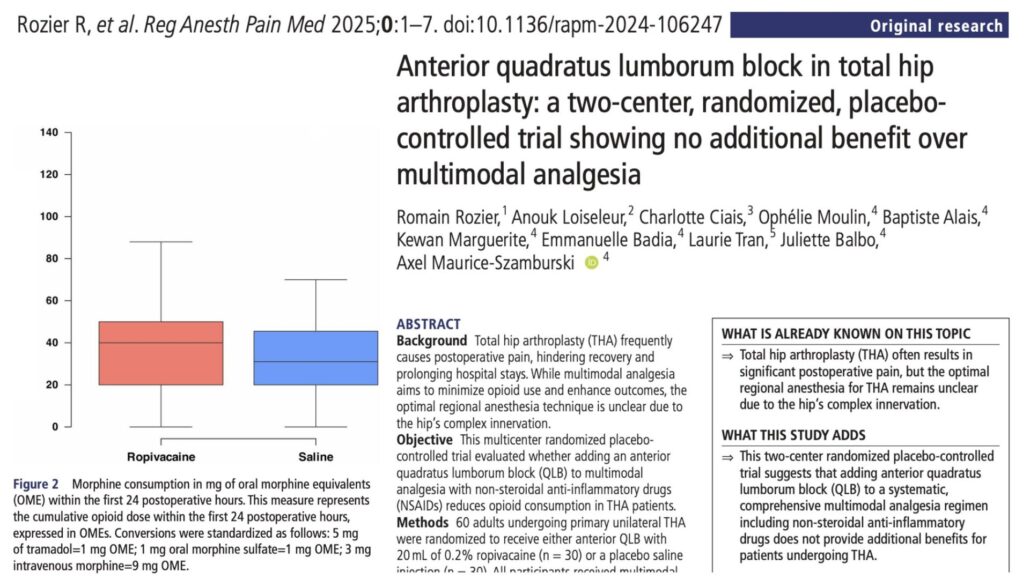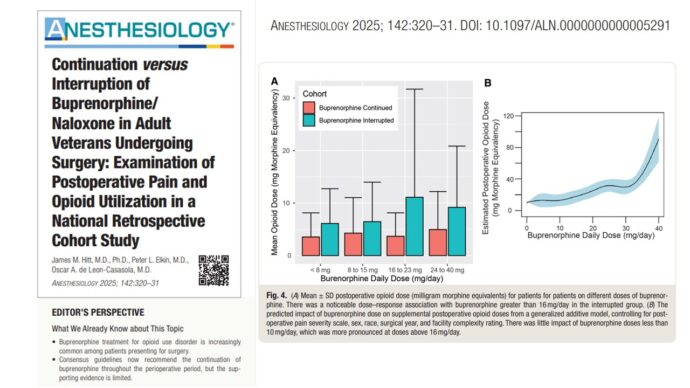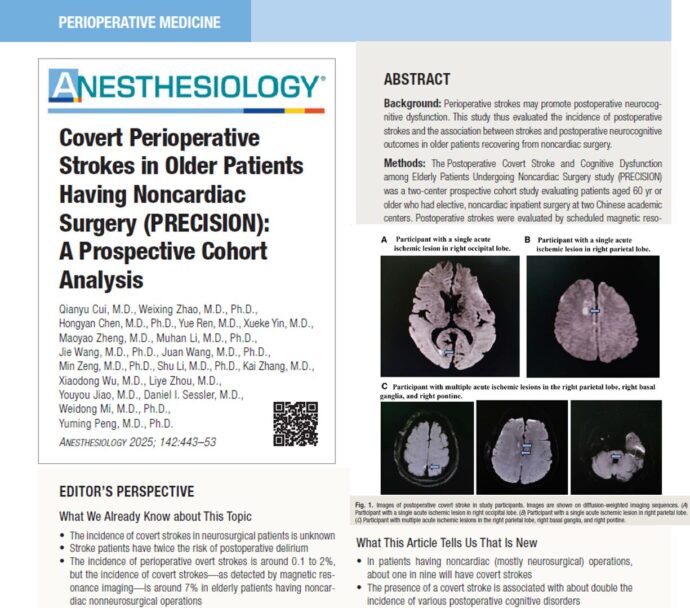
Anterior quadratus lumborum block in total hip arthroplasty
Total hip arthroplasty (THA) is a frequently performed surgical procedure to improve mobility and quality of life in patients with advanced hip joint disease. However, significant postoperative pain is a common challenge and can hinder recovery, delay rehabilitation, and increase opioid consumption. Multimodal analgesia, incorporating a combination of systemic and regional techniques, has become the cornerstone of postoperative pain management in THA. The anterior quadratus lumborum block (QLB) has emerged as a potential technique for addressing the complex innervation of the hip joint. This multicenter, randomized, placebo-controlled trial evaluated whether adding anterior QLB to multimodal analgesia improves postoperative outcomes in patients undergoing THA.
Study objective and methods
The study aimed to assess the impact of anterior QLB on postoperative pain, opioid consumption, and functional recovery in THA patients.
- Design: Multicenter, randomized, double-blind, placebo-controlled trial.
- Participants: 60 patients undergoing primary unilateral THA were randomized to receive either anterior QLB with 20 mL of 0.2% ropivacaine (n = 30) or a placebo saline injection (n = 30).
- Intervention: Anterior QLB was performed preoperatively with ultrasound guidance, injecting local anesthetic or saline between the quadratus lumborum and psoas major muscles. Both groups received multimodal analgesia, including NSAIDs, acetaminophen, ketamine, and dexamethasone.
- Primary outcome: Cumulative opioid consumption (oral morphine equivalents) in the first 24 hours postoperatively.
- Secondary outcomes: Pain scores, time to first standing, walking distance, quadriceps strength, and 3-month functional recovery metrics.
Key findings
- Opioid consumption: There was no significant difference in cumulative opioid consumption between the QLB and placebo groups. Median opioid use in the first 24 hours was 40 mg (IQR 20–50 mg) for the QLB group and 31 mg (IQR 20–45 mg) for the placebo group (P = 0.6).
- Pain scores: Pain intensity was similar between the two groups at all measured time points. The QLB group did not demonstrate a significant reduction in elevated pain scores (NRS > 3) compared to the placebo group.
- Functional recovery: No differences were observed in functional recovery metrics between the two groups. Time to first standing, walking distance, and quadriceps strength were comparable. At 3 months postoperatively, both groups demonstrated similar progress in walking distance and return to physical activity, with no differences in analgesic requirements.
- Safety: No block-related complications, such as hematoma, nerve injury, or infection, were reported, confirming the safety of anterior QLB in this context.
Conclusion
Adding anterior QLB to a comprehensive multimodal analgesia regimen did not significantly improve postoperative pain control, reduce opioid use, or enhance recovery outcomes in THA patients. These findings suggest that anterior QLB may not provide additional benefit when combined with an effective multimodal analgesia strategy. While the block was safe and well-tolerated, its clinical utility appears limited for routine use in THA.
Future research
- Further studies should explore alternative regional anesthesia techniques or refine anterior QLB methods to achieve better analgesic outcomes in THA. Larger trials assessing specific patient subgroups or using modified multimodal regimens could clarify the role of anterior QLB in postoperative pain management.
For more detailed information, refer to the full article in RAPM.
Rozier R, Loiseleur A, Ciais C, et al. Anterior quadratus lumborum block in total hip arthroplasty: a two-center, randomized, placebo-controlled trial showing no additional benefit over multimodal analgesia. Reg Anesth Pain Med. Published online February 10, 2025.
Download the Nerve Blocks App HERE for in-depth insights on the quadratus lumborum block. Prefer a physical copy? The bestselling NYSORA Nerve Blocks App is available in book format — an essential resource for mastering nerve blocks! And for a digital learning experience, check out the Nerve Blocks Manual Course on NYSORA’s LMS!



